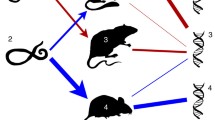Abstract
Numerous biological interactions, such as interactions between T cell receptors or antibodies with antigens, interactions between enzymes and substrates, or interactions between predators and prey are often not strictly specific. In such less specific, or “sloppy,” systems, referred to here as degenerate systems, a given unit of a diverse resource (antigens, enzymatic substrates, prey) is at risk of being recognized and consumed by multiple consumers (lymphocytes, enzymes, predators). In this study, we model generalized degenerate consumer-resource systems of Lotka–Volterra and Verhulst types. In the degenerate systems of Lotka–Volterra, there is a continuum of types of consumer and resource based on variation of a single trait (characteristic, or preference). The consumers experience competition for a continuum of resource types. This non-local interaction system is modeled with partial differential-integral equations and shows spontaneous self-structuring of the consumer population that depends on the degree of interaction degeneracy between resource and consumer, but does not mirror the distribution of resource. We also show that the classical Verhulst (i.e. logistic) single population model can be generalized to a degenerate model, which shows qualitative behavior similar to that in the degenerate Lotka–Volterra model. These results provide better insight into the dynamics of selective systems in biology, suggesting that adaptation of degenerate repertoires is not a simple “mirroring” of the environment by the “fittest” elements of population.
Similar content being viewed by others
References
Atamas, S.P., 1996. Self-organization in computer-simulated selective systems. BioSystems 39(2), 143–151.
Atamas, S.P., 2003. Hasard et Dégénérescence. Science Et Avenir Hors-Série, vol. 136, pp. 34–39; or http://biobitfield.com/sea/ for English version.
Atamas, S.P., 2005. Les Affinités Electives. Pour la Science, vol. 46, pp. 39–43; or http://biobitfield.com/pls/ for English version
Atamas, S.P., Luzina, I.G., Handwerger, B.S., White, B., 1998. 5′-Degenerate 3′-dideoxy-terminated competitors of PCR primers increase specificity of amplification. BioTechniques 24(3), 445–450.
Darwin, C., 1859. On the Origin of Species by Means of Natural Selection, or the Preservation of Favoured Races in the Struggle for Life. John Murray, London.
Edelman, G.M., Gally, J.A., 2001. Degeneracy and complexity in biological systems. Proc. Natl. Acad. Sci. USA 98(24), 13 763–13 768.
Edelman, G.M., Mountcastle, V.B., 1978. The Mindful Brain. MIT Press, Cambridge.
Fischer, E.P., Lipson, C., 1988. Thinking about Science: Max Delbruck and the Origin of Molecular Biology. Norton, New York.
Gabriel, J.-P., Saucy, F., Bersier, L.-F., 2005. Paradoxes in the logistic equation? Ecol. Model. 185(1), 147–151.
Goel, M., Krishnan, L., Kaur, S., Kaur, K.J., Salunke, D.M., 2004. Plasticity within the antigen-combining site may manifest as molecular mimicry in the humoral immune response. J. Immunol. 173(12), 7358–7367.
Greenaway, P., Raghaven, S., 1998. Digestive strategies in two species of leaf-eating land crabs (Brachyura:Gecarcinidae) in a rain forest. Physiol. Zool. 71(1), 36–44.
Jerne, N.K., 1967. Antibodies and learning: selection versus instruction. In: Quarton, G.C., Melnechuk, T., Schmitt, F.O. (Eds.), The Neurosciences, pp. 200–205. The Rockefeller University Press, New York.
Jury, E.I., 1971. “Inners” approach to some problems of system theory. IEEE Trans. Autom. Control AC-16, 233–240.
Leonardo, A., 2005. Degenerate coding in neural systems. J. Comput. Physiol. A, Neuroethol. Sens. Neural. Behav. Physiol. 191(11), 995–1010.
Malcolm, J.R., 1994. Edge effects in central Amazonian forest fragments. Ecology 75(8), 2438–2445.
Manivel, V., Bayiroglu, F., Siddiqui, Z., Salunke, D.M., Rao, K.V., 2002. The primary antibody repertoire represents a linked network of degenerate antigen specificities. J. Immunol. 169(2), 888–897.
Miles, J., 1971. Integral Transforms in Applied Mathematics. Cambridge Univ. Press, Cambridge.
Ohno, S., 1978. The significance of gene duplication in immunoglobulin evolution (Epimethean natural selection and Prometean evolution). In: Litman, G.W., Good, R.A. (Eds.), Inmunoglobulins, pp. 197–215. Plenum Medical Book, New York.
Selin, L.K., Cornberg, M., Brehm, M.A., Kim, S.K., Calcagno, C., Ghersi, D., Puzone, R., Celada, F., Welsh, R.M., 2004. CD8 memory T cells: cross-reactivity and heterologous immunity. Semin. Immunol. 16(5), 335–347.
Schedlbauer, J.L., Finegan, B., Kavanagh, K.L., 2007. Rain forest structure at forest–pasture edges in Northeastern Costa Rica. Biotropica 39(5), 578–584.
West-Eberhard, M.J., 2005. Developmental plasticity and the origin of species differences. Proc. Natl. Acad. Sci. USA 102, 6543–6549.
Author information
Authors and Affiliations
Corresponding author
Rights and permissions
About this article
Cite this article
Atamas, S.P., Bell, J. Degeneracy-Driven Self-Structuring Dynamics in Selective Repertoires. Bull. Math. Biol. 71, 1349–1365 (2009). https://doi.org/10.1007/s11538-009-9404-z
Received:
Accepted:
Published:
Issue Date:
DOI: https://doi.org/10.1007/s11538-009-9404-z




